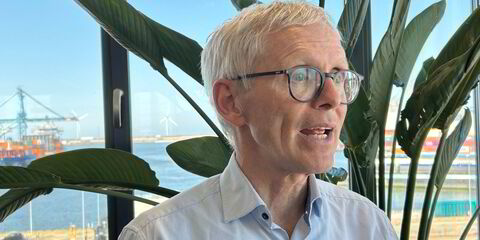Decarbonising shipping is a complex challenge. There is no silver bullet; no one-size-fits-all fuel or technology solution to steer us towards a decarbonised future. The industry cannot wait for the mass availability of net-zero-carbon fuels.
Fortunately, it does not have to. Instead, LNG can be an answer for shipping’s challenges today and in the future.
It is a fact that LNG is the lowest-carbon fuel currently available to shipping at scale, and that it can reduce greenhouse gas (GHG) emissions by up to 23% well-to-wake (WTW).
Beyond GHG, it emits virtually no sulphur oxides or particulate matter either, while significantly reducing NOx emissions as well. It also offers a long-term and flexible pathway to decarbonisation through the use of liquefied e-methane [synthetic methane] — a potentially net-zero, hydrogen-based fuel — and with liquefied bio-methane in the interim.
We believe LNG will also have a role in enabling hydrogen in the future, by helping to unlock the improved energy conversion efficiency of fuel cell technology for shipping.
By choosing LNG, shipping can therefore accelerate decarbonisation while other low- and zero-carbon alternatives are being developed.
However, It is not all plain sailing.
Methane emissions are a key challenge associated with LNG. This includes leakage from the upstream supply chain and methane slip — when unburned methane is released from the energy converter and emitted into the atmosphere.
The impact of methane emissions is significant, since it has a Global Warming Potential (GWP) 30 times higher than that of CO2 over a 100-year time span. Which is why, at COP26 last year, global leaders committed to reducing methane emissions by at least 30% by 2030, with accurate measurement as a priority.
On methane slip, the industry has made significant progress over the last two decades, and more is being done to reduce it further. But because methane slip contributes to wasted energy, it is in the environmental and commercial interests of shipping to reduce it.
There are three ways shipping can continue to minimise methane slip.
Technological action
Since methane slip is not a fuel issue but an energy conversion one — occurring with varying degrees depending on the engines used — operators should consider the methane slip performance of their specific engines. This issue is more prevalent in Otto cycle (low-pressure) engines, while Diesel cycle (high-pressure) engines can reduce methane slip to negligible levels.
There are multiple solutions being developed by the industry, including catalyst-based technologies and after-treatment solutions that have demonstrated methane conversion efficiency of more than 95% and 99%, respectively.
However, progress in reducing methane slip has been hindered by the challenges in measurement — driven in part by insufficient, accurate data for different engines and operational profiles. To help overcome this, Shell will soon launch a measurement campaign to improve the baseline accuracy related to methane slip from different engine types.
Legislative action
While present technologies can significantly reduce methane slip, their use is not widespread enough. And, until regulation more effectively enables shipowners to monitor, verify and control emissions, this is unlikely to change.
Although the International Maritime Organization is considering incorporating WTW GHG emissions into its existing emissions rules, the industry should be pushing for further regulations.
This includes the inclusion of GHG emissions into the EU Emissions Trading System scope and proposed IMO market-based measures — a move that would help to incentivise the adoption of emission-reduction fuels and technologies in the industry.
Collaborative action
But none of this can happen without collaboration. For Shell, this means working with the industry to adopt accurate emissions monitoring, improve combustion efficiency, and develop after-treatment solutions — for both newbuildings and retrofitted designs.
Ultimately, we expect that this will help us develop and deploy a range of technologies to minimise methane slip from engines, through a combination of energy conversion and after-treatment improvements, by as early as 2024.
Beyond shipping, as a member of the Oil and Gas Climate Initiative, Shell also aims to eliminate methane emissions from oil and gas operations by 2030.
While we recognise as an industry that significant progress has been made to reduce methane emissions, there is still more we need to do together.
Minimising methane emissions helps to pave the way to further decarbonise LNG and, in turn, helps enhance shipping’s journey to a net-zero emissions future.(Copyright)





